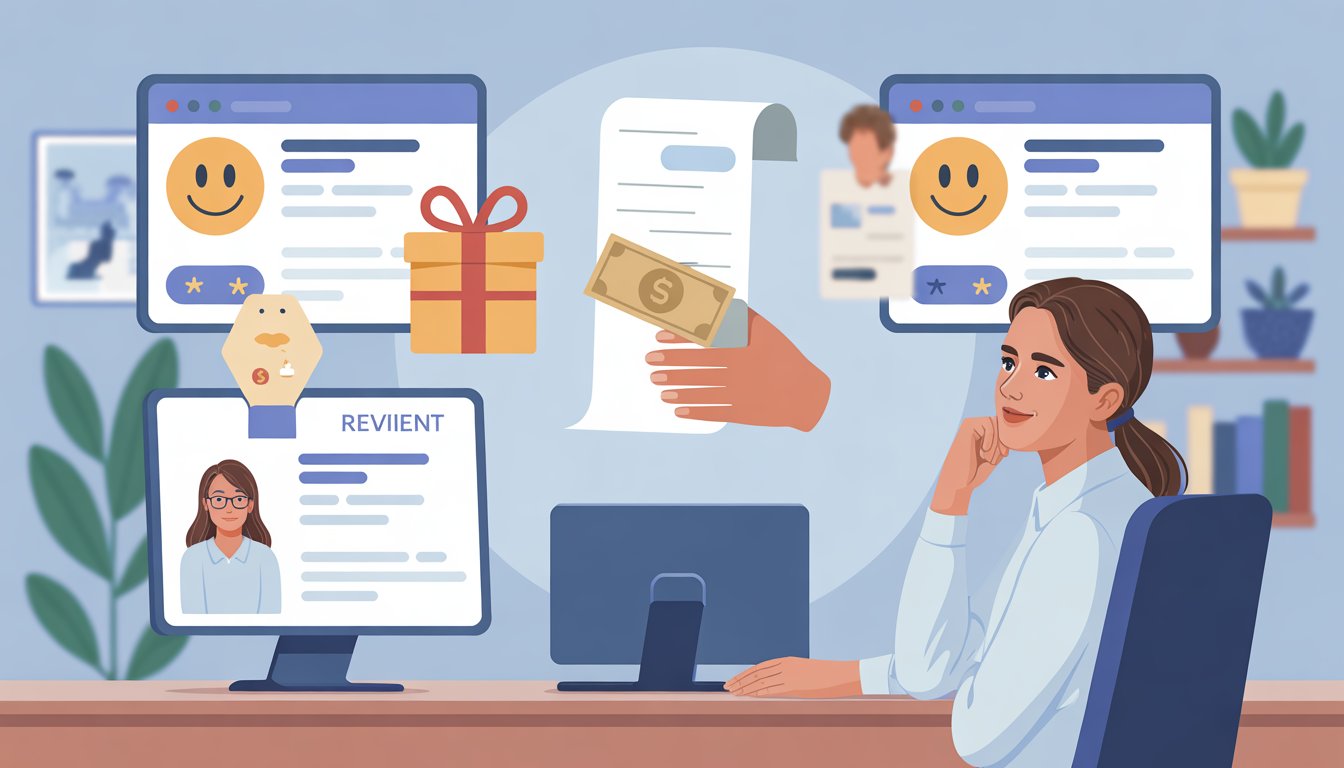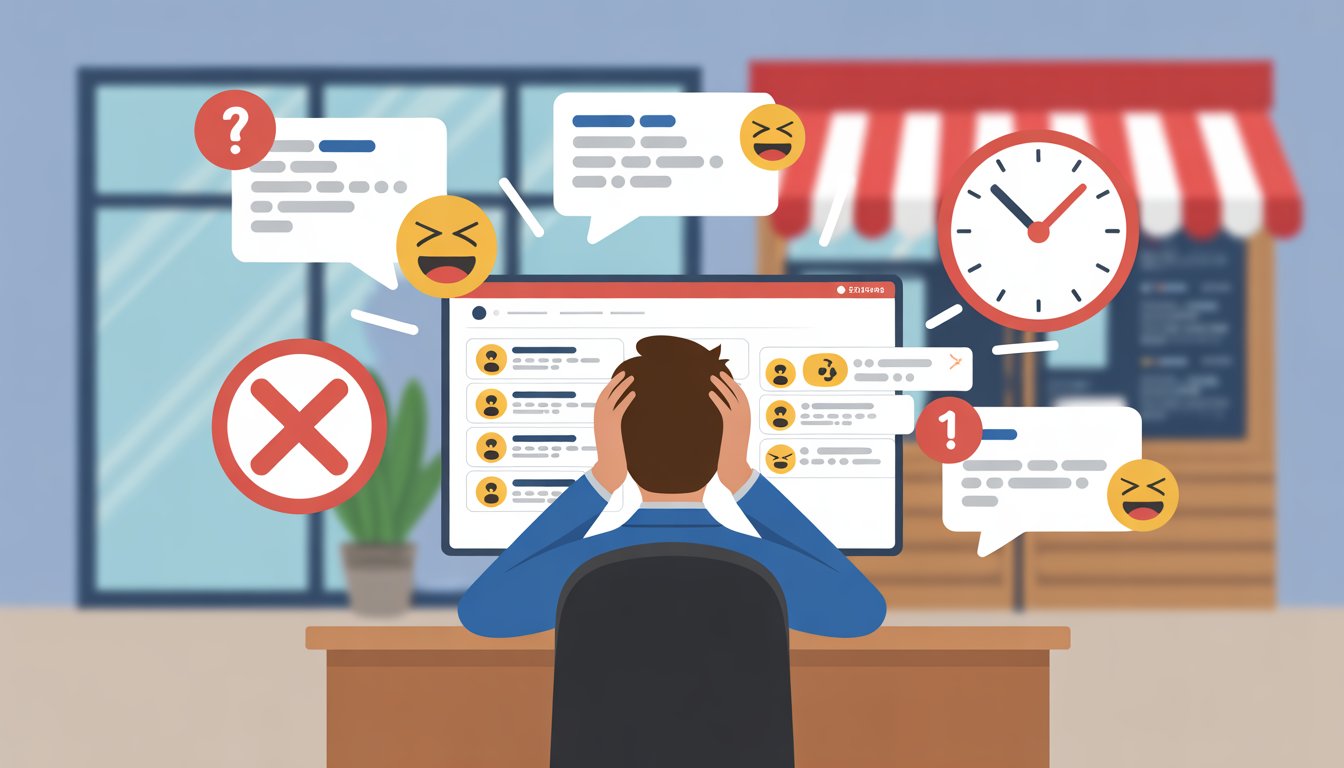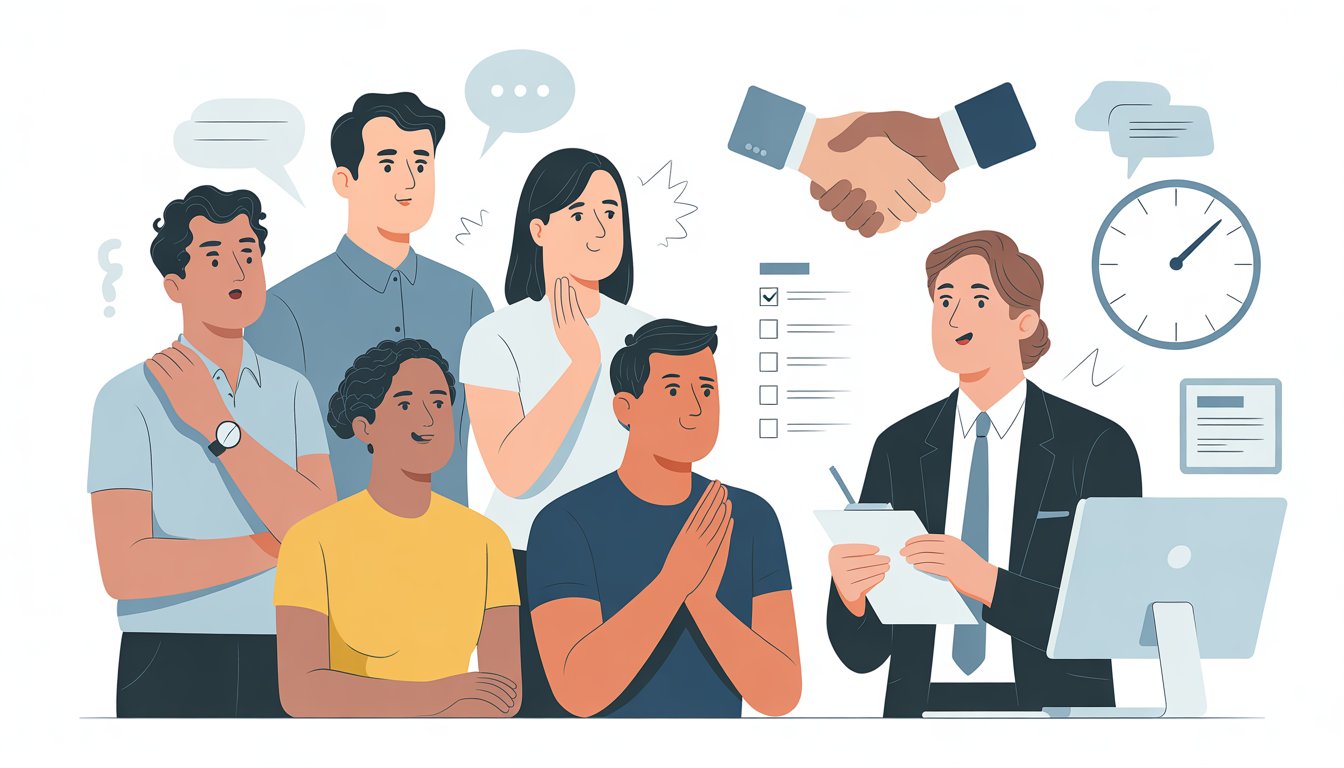When a customer leaves a negative review about your business, your first instinct might be to offer a refund or discount in your public response. However, this approach can backfire and create more problems than it solves.
You should not offer refunds or discounts in public review responses because it can appear manipulative, violate platform policies, and encourage other customers to leave negative reviews expecting compensation.

Public offers of compensation send the wrong message to both the reviewer and future customers. They can make it look like you're trying to buy better reviews rather than genuinely addressing the customer's concerns.
This practice also signals to other potential customers that leaving a negative review might result in free money or products.
The better approach involves responding professionally to acknowledge the issue and showing you care about customer satisfaction. Take the conversation private to resolve specific problems.
This strategy protects your reputation while still allowing you to make things right with unhappy customers behind the scenes.
Key Takeaways
- Never offer refunds or discounts publicly as it can appear like you're buying positive reviews
- Take compensation discussions to private channels to resolve customer issues professionally
- Focus on addressing the customer's concerns directly rather than offering immediate financial incentives
Understanding the Role of Refunds and Discounts in Review Responses

Refunds and discounts serve as powerful tools to resolve customer complaints while demonstrating your commitment to customer satisfaction. These offers can transform negative experiences into positive outcomes when used strategically.
Defining Refunds and Discounts in Customer Feedback Context
A refund in review responses means offering to return the customer's money for their purchase. This shows you take full responsibility for their poor experience.
Discounts involve offering percentage savings or dollar amounts off future purchases. These keep the customer engaged with your business while addressing their concerns.
Both tools work differently in public settings. When you offer these solutions publicly, other customers see your response.
This affects how people view your brand. Refunds work best for serious product failures or service problems.
They show you prioritize customer experience over keeping revenue from unhappy customers. Discounts work well for minor issues or when you want to encourage repeat business.
They balance addressing complaints with maintaining customer relationships. Your choice between refunds and discounts depends on the problem's severity and your business goals.
Common Scenarios for Public Offers
Product defects or damage call for immediate refund offers. Customers expect their money back when items arrive broken or don't work as promised.
Shipping delays often warrant discount codes for future orders. This acknowledges the inconvenience without full financial liability.
Service quality issues may need either option depending on severity:
- Minor problems: 10-20% discount codes
- Major failures: Full or partial refunds
Expectation mismatches typically benefit from exchanges or partial refunds. This shows flexibility while educating other customers about your products.
Billing errors always require immediate refund offers. These situations damage trust quickly if not handled properly.
Multiple complaints from one customer may need escalation to private messages rather than public offers. This prevents setting unrealistic expectations for other customers.
The key is matching your offer to the problem's impact on customer satisfaction.
Impact on Customer Perception
Public refund offers build trust by showing accountability. Other customers see you stand behind your products and fix problems quickly.
However, frequent public refunds may signal quality control issues. This can hurt your reputation and reduce customer confidence in your products.
Discount offers appear generous while protecting your revenue. They encourage customers to give your business another chance instead of leaving permanently.
Positive impacts include:
- Increased trust in your brand
- Higher customer satisfaction scores
- Better review ratings over time
- Reduced negative word-of-mouth
Potential risks involve:
- Other customers demanding similar offers
- Reduced profit margins
- Perception of poor quality control
Smart businesses balance these factors by setting clear policies. You should offer refunds for legitimate product failures while using discounts for service issues.
Your response speed also affects perception. Quick offers show you monitor feedback and care about customer experience.
When to Offer Refunds or Discounts in Response to Reviews

Knowing when to offer financial compensation in review responses requires careful judgment and clear criteria. You need to balance customer satisfaction with protecting your business from unreasonable demands.
Identifying Genuine Service Failures
Look for specific details in negative reviews that point to real problems. These include delayed deliveries, broken products, poor service quality, or billing errors.
Clear signs you should offer compensation:
- Product defects or damage during shipping
- Service not delivered as promised
- Staff behavior that was genuinely unprofessional
- Technical issues that prevented proper service delivery
Reviews with specific dates, order numbers, or detailed descriptions usually indicate real problems. Vague complaints without details might need more investigation.
Active listening means reading between the lines. A customer who mentions multiple failed attempts to resolve an issue likely deserves compensation.
Distinguishing Between Fair and Unfair Demands
Not every complaint warrants a refund or discount. You must separate legitimate grievances from unreasonable expectations.
Fair demands typically involve:
- Services that didn't meet stated promises
- Products that arrived damaged or defective
- Poor treatment from your staff
- Billing mistakes or overcharges
Unfair demands often include:
- Complaints about published policies they knew beforehand
- Requests that go beyond industry standards
- Attempts to get free items without valid reasons
- Reviews that seem designed to manipulate you
Customer loyalty matters, but don't reward bad behavior. Regular customers with genuine complaints deserve more consideration than first-time buyers making unreasonable demands.
Handling Edge Cases and Repeat Requests
Some situations don't fit standard guidelines. Use your judgment when dealing with complicated cases or customers who frequently request compensation.
Edge cases require special attention:
- Medical emergencies that prevented service use
- Weather or natural disasters affecting delivery
- Miscommunication about service expectations
- Cultural differences in service standards
Set limits on repeat requests from the same customer. One person shouldn't receive multiple discounts within a short time period unless each issue is completely separate.
Document all compensation offers to track patterns. This helps you spot customers who abuse your goodwill and protect your business from excessive demands.
Consider offering alternative solutions before money. Free replacement services, extended warranties, or future credits can satisfy customers while costing you less.
Risks and Benefits of Offering Public Compensation
Offering refunds or discounts in public review responses creates immediate financial costs while potentially building stronger customer relationships. This approach directly impacts your revenue, brand authority, and sets precedents for how future customers expect you to handle complaints.
Influence on Future Customer Expectations
When you offer compensation in public responses, you create a visible standard for how you handle problems. Other customers will see these exchanges and expect similar treatment when they face issues.
This can lead to increased demands for compensation. Customers may post negative reviews specifically hoping to receive discounts or refunds they see you've given others.
Your response pattern becomes a reference point. If you give a 20% discount for one complaint, similar issues will likely generate expectations for the same compensation level.
However, consistent public compensation can also build customer loyalty. When people see you actively fix problems with real solutions, they feel more confident about doing business with you.
The key is setting clear boundaries about what situations warrant compensation and sticking to those guidelines consistently.
Potential for Feedback Manipulation
Public compensation creates opportunities for customers to game the system. Some people may write negative feedback specifically to get free products or discounts.
This manipulation can come in several forms:
- Exaggerated complaints about minor issues
- False claims about products or services
- Repeat complaints from the same customers using different accounts
You need systems to verify complaints before offering compensation. Check purchase records and communication history to confirm legitimate issues.
Consider moving compensation discussions to private channels when possible. This reduces the visibility that encourages manipulative behavior while still resolving genuine customer problems.
Watch for patterns in complaints that seem designed to extract compensation rather than solve real problems.
Effect on Revenue and Brand Authority
Direct compensation obviously impacts your revenue through immediate costs. A $50 refund on a $100 purchase cuts your profit margin significantly on that transaction.
However, public compensation can increase your authority as a business that stands behind its products. This reputation often leads to more sales and customer referrals over time.
The math works differently for each business:
- High-margin products can absorb compensation costs more easily
- Low-margin businesses need to be more selective about public compensation
- Service businesses may offer future credits instead of cash refunds
Brand authority grows when customers see you take responsibility for problems. This builds trust that can lead to larger purchases and repeat business.
Track the lifetime value of customers who receive public compensation. Many become loyal customers who spend more money over time than the initial compensation cost.
Legal and Policy Considerations for Public Refunds and Discounts
When offering refunds or discounts in public review responses, you must follow specific business laws and consumer protection regulations. Proper documentation protects your business from disputes and legal issues.
Understanding Business Law Implications
Your public promises create binding legal agreements. When you offer a refund or discount in a review response, courts may consider this a contract.
You cannot discriminate when making public offers. If you give one customer a refund publicly, other customers with similar issues may have legal grounds to expect the same treatment.
Key legal risks include:
- Breach of contract claims
- False advertising accusations
- Consumer fraud allegations
Small claims court cases often arise from unmet public promises. Customers screenshot your public offers as evidence.
They use these screenshots to prove you agreed to specific terms. Your public responses must match your actual policies.
If your return policy says "no refunds after 30 days" but you publicly offer refunds after 60 days, this creates confusion and legal exposure.
Key Points from Consumer Protection Law
Consumer protection law requires honest and fair business practices. You cannot make false promises in public responses just to improve your image.
The Consumer Review Fairness Act protects customers' rights to share honest opinions. You cannot offer incentives that require customers to change or remove negative reviews.
Prohibited practices include:
- Conditional offers that require review changes
- Fake promises you don't intend to keep
- Discriminatory treatment based on review content
State consumer protection laws vary by location. Some states have stricter rules about public advertising and promises.
Your business must follow the laws in your state and your customers' states. Document all interactions when offering public refunds.
Keep records of what you promised and what you delivered. This protects you if disputes arise later.
Proper Documentation to Avoid Disputes
Create written policies before making public offers. Document your standard procedures for handling review responses and customer complaints.
Essential documentation includes:
- Screenshots of original reviews and your responses
- Email exchanges with customers
- Payment records for refunds or discounts
- Notes about resolution outcomes
Use seller help resources from major platforms. These resources explain platform-specific rules and best practices for public responses.
Set up tracking systems for public offers. Create spreadsheets or use customer service software to monitor promises made in public responses.
Include deadlines and completion status. Train your team on documentation requirements.
Everyone who responds to reviews must understand what records to keep and how to properly document offers. Keep records for at least three years.
Some consumer protection laws allow customers to file complaints years after the original transaction. Proper documentation helps you defend against false claims.
Best Practices for Responding to Negative Reviews
Successful review responses require three core skills: showing genuine empathy, staying professional across all interactions, and knowing when to take sensitive conversations private. These practices help you turn complaints into opportunities for building trust.
Using Active Listening and Empathy
Active listening means reading the full review carefully before responding. Look for the specific problems the customer faced.
Don't just focus on defending your business. Show empathy by acknowledging their feelings.
Use phrases like "I understand how frustrating this must have been" instead of generic statements. This makes customers feel heard.
Avoid these empathy mistakes:
- "We're sorry you feel that way"
- "That's not typically how our service works"
- "Other customers haven't had this problem"
Instead, try responses like:
- "I'm sorry this happened to you"
- "We didn't meet your expectations, and that's on us"
- "Your experience wasn't acceptable"
Good customer support teams train staff to reflect the customer's concerns back to them. This shows you actually read their complaint.
When customers see you understand their specific situation, they're more likely to trust your solution.
Maintaining Professionalism and Consistency
Your response tone should stay calm and helpful, even when reviews feel unfair. Defensive replies make your business look bad to future customers reading the review.
Create standard response templates for common complaints. This ensures consistency across your customer service team.
Always customize each response with specific details from the customer's experience. Using the customer's name when possible keeps interactions personal.
Stay factual, not emotional. Offer concrete solutions and take responsibility without making excuses.
Train all team members who handle reviews to use the same respectful tone. Mixed response styles confuse customers and hurt your brand image.
Response time matters too. Customers expect replies within 1-2 days.
Quick, professional responses show you care about fixing problems fast.
Deciding When to Move Disputes Offline
Some review situations need private conversations. Move complex disputes offline when they involve personal information, billing details, or legal issues.
Use phrases like "Please contact us at [email] so we can resolve this properly." This shows other readers you're taking action while protecting customer privacy.
Move conversations offline when multiple back-and-forth exchanges start happening. Take action if the customer shares private account details publicly.
The issue may require detailed investigation. Emotions getting heated in public comments is another sign to switch to private communication.
Post a brief, professional response before moving the conversation offline. Then invite them to continue privately.
Some customers prefer public discussions to hold businesses accountable. Respect their choice but offer private options for faster resolution.
Leveraging Automation and Internal Systems
Automation tools can streamline your review response process while maintaining quality and consistency. The right systems help you balance efficient workflows with personalized customer interactions.
Automating and Standardizing Review Responses
Automated systems can handle basic review responses and route complex cases to human agents. This reduces response times and ensures consistency across all public interactions.
Set up automated triggers for common review types. Positive reviews can receive instant thank-you messages.
Negative reviews about specific issues like shipping delays can get pre-written responses that acknowledge the problem. Create response templates for frequent scenarios.
For product defects, use a standardized apology with refund offer. For shipping issues, provide an explanation with a discount code.
For service complaints, include personal contact information for follow-up. Use AI-powered tools to categorize reviews automatically.
These systems can identify sentiment, extract key issues, and suggest appropriate responses based on your established policies. Automation benefits include faster response times (under 24 hours) and consistent messaging across platforms.
Reduced manual workload for staff and better tracking of resolution outcomes are also advantages. Monitor automated responses regularly.
Check that they sound natural and address customer concerns properly. Update templates based on new product issues or policy changes.
Balancing Personalization with Efficiency
Automated systems work best when combined with human oversight for complex situations. Use automation for initial responses while keeping room for personal touches.
Set up escalation rules for sensitive reviews. Reviews mentioning legal action, safety concerns, or viral complaints should go directly to experienced team members.
Personalize automated responses with customer names and specific purchase details. This makes standard templates feel more genuine.
Reference specific products mentioned in reviews. Include purchase dates or order numbers when relevant.
Adjust tone based on review sentiment. Add location-specific information for local businesses.
Train your team to recognize when automation isn't enough. Complex complaints about multiple issues or emotional responses often need human intervention.
Use data from automated systems to improve your processes. Track which automated responses get positive follow-up reactions and which ones lead to escalated complaints.
Reserve full personalization for high-value customers or serious reputation threats. This targeted approach maximizes your team's time while maintaining good customer relationships.
Frequently Asked Questions
Businesses need clear guidelines when handling review responses, especially regarding legal compliance and ethical practices. These common questions address platform policies, incentive regulations, and professional response strategies.
What are the legal considerations of offering discounts for reviews?
You must comply with FTC guidelines that require clear disclosure of any incentivized reviews. The discount or incentive must be disclosed prominently in the review itself.
Platform policies vary significantly. Google prohibits incentivized reviews entirely, while other platforms allow them with proper disclosure.
You cannot require positive reviews in exchange for discounts. This violates most platform terms and creates legal liability for false advertising.
State laws may also apply to review incentives. Some jurisdictions have specific requirements for promotional disclosures and consumer protection.
How should a business handle unfair or negative reviews on platforms like Yelp?
Respond professionally without defending yourself at length. Acknowledge the customer's concern and invite them to discuss details privately.
Never accuse the reviewer of being fake or dishonest in your public response. This can escalate the situation and damage your reputation further.
Flag reviews that violate platform policies for fake content, spam, or harassment. Most platforms have specific procedures for disputing illegitimate reviews.
Focus your response on demonstrating good customer service to future readers. Your reply shows potential customers how you handle problems.
What is the best practice for responding to customer requests for discounts?
Move discount discussions to private channels immediately. Public platforms are not appropriate for negotiating specific compensation details.
Acknowledge the request professionally in your public response. Thank them for their feedback and provide contact information for private follow-up.
Establish clear refund and discount policies before issues arise. This prevents inconsistent responses and potential legal problems.
Document all discount offers and resolutions. This creates a paper trail for accounting purposes and helps track customer satisfaction trends.
Are there any legal ramifications to providing incentives for customers to leave positive reviews?
Yes, the FTC requires clear and conspicuous disclosure of any material connection between your business and the reviewer. Hidden incentives violate federal guidelines.
Reviews obtained through undisclosed incentives can be considered deceptive advertising. This creates liability under consumer protection laws.
Platform violations can result in review removal or account suspension. Many review sites prohibit incentivized reviews entirely.
Class action lawsuits have targeted businesses for fake review schemes. The legal costs often exceed any marketing benefits from incentivized reviews.
How can a company ethically encourage reviews without offering compensations?
Ask customers directly after positive interactions or successful purchases. Timing your request increases the likelihood of honest feedback.
Make the review process simple by providing direct links to your review profiles. Remove barriers that prevent customers from leaving feedback.
Follow up with customers via email after purchase completion. Include clear instructions and links to relevant review platforms.
Provide excellent customer service consistently. Satisfied customers naturally leave positive reviews without incentives or prompts.
What guidelines should be followed when replying to reviews to maintain brand integrity?
Respond within 24-48 hours to show active engagement. Quick responses demonstrate that you value customer feedback.
Keep responses concise and professional. Long, defensive replies can make your business appear unprofessional.
Use the customer's name when possible. Reference specific details from their review to show you actually read their feedback.
Sign responses with a real name or initials rather than generic company signatures. Human responses build more trust than corporate-sounding replies.










